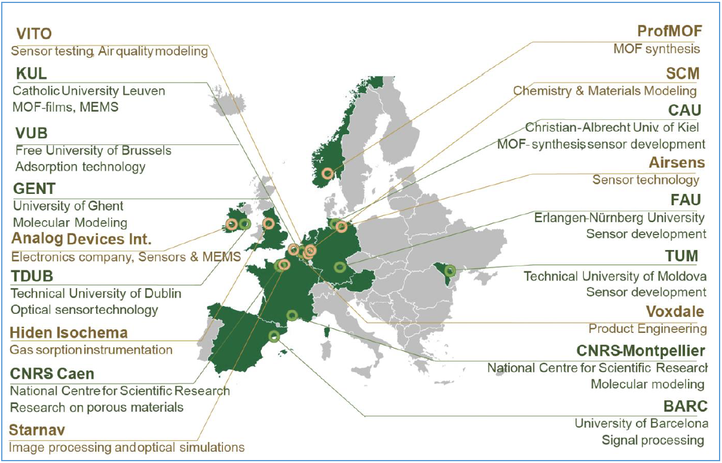Marie Skłodowska-Curie Action Doctoral Network - SENNET
Introduction
The Marie-Skłodowska-Curie Doctoral Network “Porous Networks for Gas Sensing” (SENNET) within the Horizon Europe Programme of the European Commission will create disruptive sensor technology for indoor air quality by incorporating porous materials and sensor technology by training 12 PhD students. Therefore the project has pooled the interdisciplinary and intersectoral expertise of leading research teams located in Europe and focused on MOF and zeolite materials (See Figure). The 9 academic beneficiaries, comprising strong and internationally recognised teams in modelling and signal processing, materials synthesis, adsorption studies and sensor fabrication and testing, have teamed up with 10 partner organisations, providing additional expertise in materials characterization, sensor design, development, fabrication, and commercialization, big data analysis, air quality monitoring, pass-production, etc. The project is coordinated by prof. Rob Ameloot (KU Leuven, Belgium) and will run from September 2022 until August 2026.
Project description
Air pollution is one of the most pressing environmental challenges worldwide. While outdoor air pollution appears often in the media, the effects of indoor air pollution are not to be underestimated since the average person spends about 22 h per day indoors. Many chemicals that decrease the quality of indoor air are emitted by carpets, paints, furniture, etc. The majority of these pollutants are volatile organic compounds (VOCs). Since VOCs can cause not only discomfort but also debilitating or even fatal conditions, it is desirable to measure VOC concentrations with high spatial and temporal resolution, via low-cost but reliable miniature sensors. However, selectively measuring harmful VOCs is particularly challenging because of the low concentration of the analyte and the multitude of interfering compounds present in indoor air. Currently available miniature sensors (e.g., metal oxide semiconductor sensors) typically cannot distinguish a VOC of interest from, for instance, an air freshener.
Breakthrough materials for developing these novel sensors for the selective detection of priority VOCs are MOFs and zeolites, crystalline, porous network materials. Because of their chemical and structural characteristics, MOFs and zeolites can capture VOCs even at trace concentrations. Moreover, the adsorption preference (or selectivity) can be tuned by changing the nature of the framework. Although these adsorption properties are potentially very promising for VOC sensors, the integration of MOFs or zeolites into real devices has been largely overlooked. Firstly, due to a lack of systematic knowledge about which of the many different MOFs or zeolites would be best suited to adsorb a particular VOC from the air, and, secondly, the lack of suitable methods to integrate these materials with a sensor technology, e.g., coating deposition and signal transduction.
SENNET will address these challenges by combining expertise from fundamental chemistry all the way through to sensor engineering, resulting in the scientific objectives outlined below. The overall approach is to combine multiple sensor elements coated by a porous material that displays cross-selective but different adsorption behaviour. The nature and concentration of the target VOC will be determined from the combined response of all the sensor elements through a multivariate calibration approach borrowed from chemometrics. The focus will be on the priority risk VOCs determined by the World Health Organization, i.e., tetrachloroethylene, formaldehyde and benzene.
Objectives
These are the objectives of SENNET:
- Because of the large numbers of MOFs (> 10,000) and zeolites (> 240), and their numerous multicomponent adsorption behaviours, an efficient screening approach is needed. High-throughput computational approaches will be developed to tackle this problem and identify structure-adsorption property relationships.
- The predicted behaviour must be validated by experimental adsorption tests for both single components and complex mixtures to fully understand the behaviour of the materials in indoor air.
- Synthesis of MOFs and zeolites and fine-tuning of their properties to obtain the required mixed-component adsorption behaviour, based on the identified structure-adsorption property relationships. The materials will be prepared in a form that facilitates their integration in sensors.
- Sensor fabrication and testing based on the most promising MOFs and zeolites. New fabrication approaches will be explored and the testing will involve real-world conditions. Different strategies to transduce the VOCs’ adsorption characteristics into a measurable signal will be benchmarked.
- Signal-processing methods will be developed to calibrate the sensors and sensor arrays and to prevent non-selective or drifting signals as a result of temperature, relative humidity, or interfering compounds.
Role of Ghent University
The Center for Molecular Modelling (CMM, Ghent University) is partner of the SENNET consortium. Prof. Van Speybroeck and Prof. Vanduyfhuys will contribute to the development of dedicated models for adsorption isotherms and dielectric constants and are the supervisors of two joint PhDs within this project.
Website
Contact
Prof. Veronique Van Speybroeck
Department EA17
Phone number: +32 9 264 65 58
E-mail
Prof. Louis Vanduyfhuys
Department EA17
Phone number: +32 9 264 65 64
E-mail
Funding info
Disclaimer
Funded by the European Union. Views and opinions expressed are however those of the author(s) only and do not necessarily reflect those of the European Union or the European Research Executive Agency (REA). Neither the European Union nor the authority can be held responsible for them.

